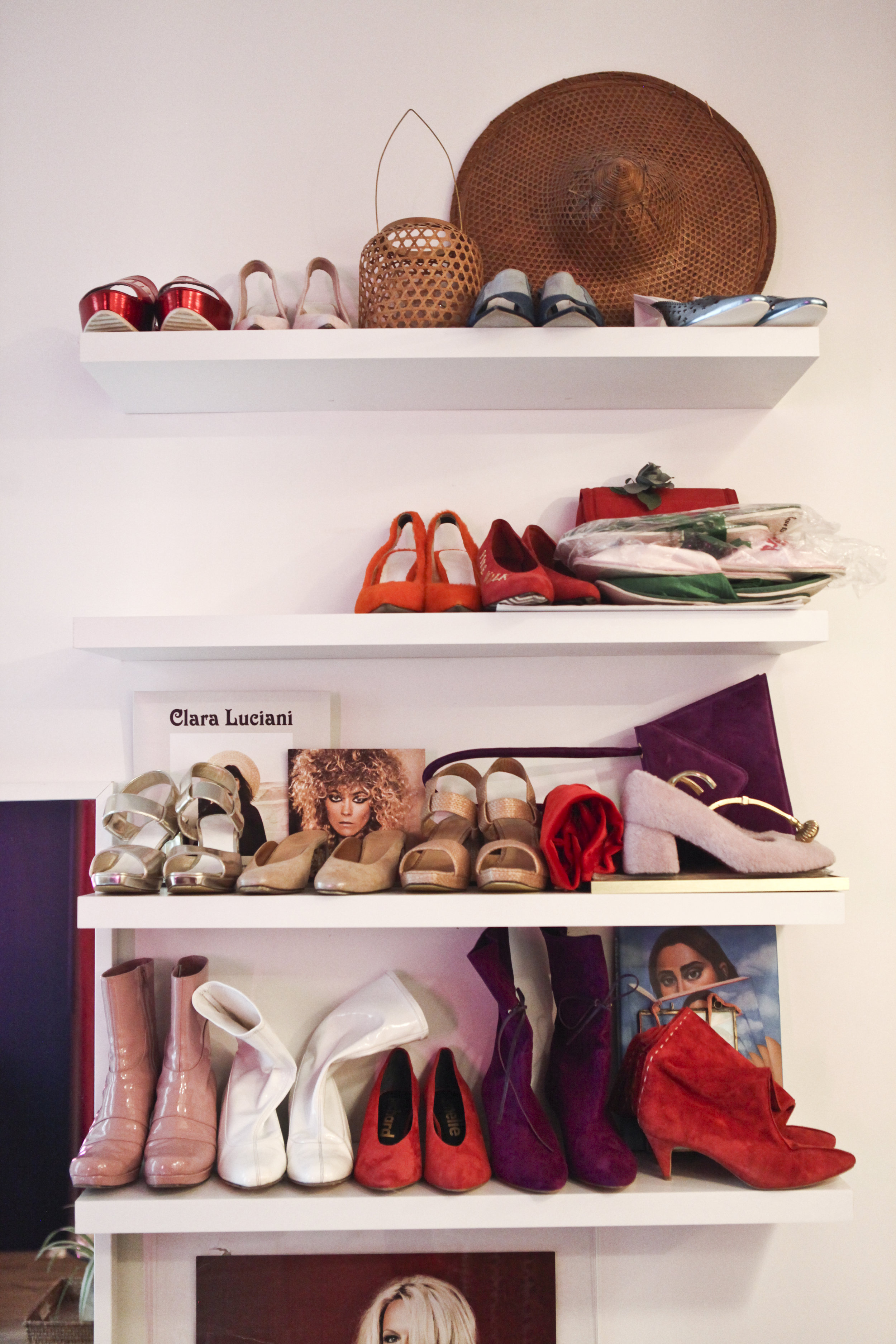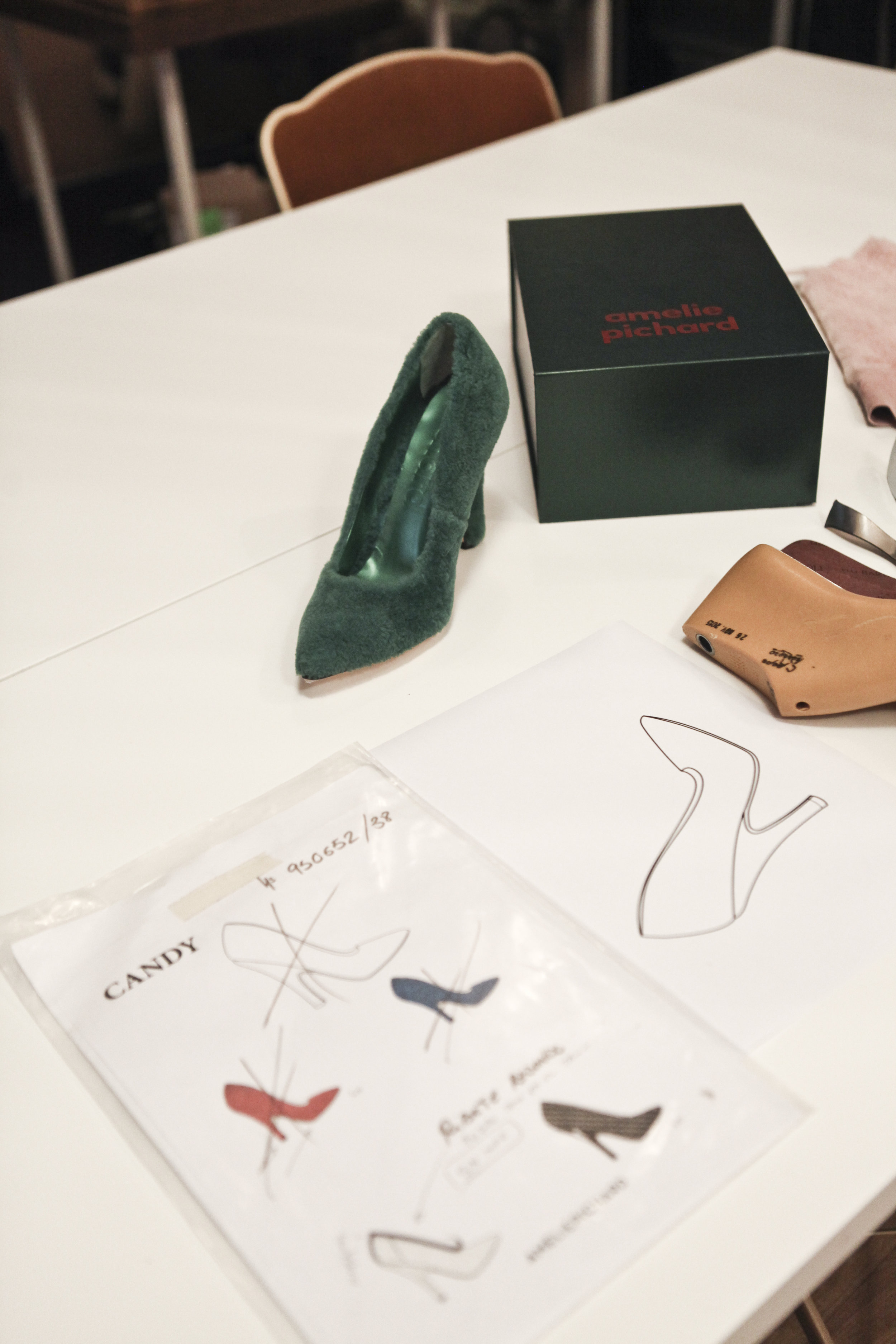Fashion Designer, Amélie Pichard
“The “Pichard girl” has walked in the shoes designed by Amelie Pichard in cities across the world. There is not just one type of girl who inspires her, but rather, the vision of Amelie is inspired by the attitude of any girl who wears her designs.”
For Amelie, the inspiration for her designs cannot be pinpointed or described into words. It is only the "Pichard girls," the term she uses for the women who wear her designs, that creates the world and personality behind the collections. This symbiotic relationship between Pichard and the customer has led to a popularity beyond Paris. It has even led to the opening of her first shop there. As a designer who has often played with the definition of femininity in her shoes and accessories, the interiors of her shop reflect her message that all women are welcome. Recommended and worn often by Paris passerby, Clemence Sigu, and NYC passerby, Syvan Mandel, the "Pichard girl" spans across the globe. In our conversation, Amelie Pichard shares her vision for the future of her brand, including her favorite and reliable spots around Paris.
What led to your career as a designer? Is it something that you have always wanted to pursue?
First, I’ve always wanted to work with women. I have been drawing a lot of women since I was 5 years old. At school, my teachers told my mum, “She will be a fashion designer.” They gave me the idea, so I became a fashion designer in ready-to-wear. One day, I met the last women’s shoemaker of Paris who was 76 years old, and I fell in love with her handwork! I decided right away to specialize in shoemaking first, then in becoming a shoe designer.
As a shoe designer, is there a particular shoe from when you were a child or teenager that captured your imagination and inspired you to one day get into fashion?
Not really. I am more into souvenirs and feelings than products. I remember one day, my dad took me to his countryside house, as my parents were divorced, and I realized that I was in the car with my house slippers. We stopped by the supermarket, and he bought me another sort of slippers because I wanted them. So I stayed one week without shoes. I was a little bit wild when I was younger. Comfort was very important for me.
Life inspires me. Being a fashion designer is more like a sociologist than anything else. It would be so narrow to tell you that I love pop music or a movie. I create in a dream where lot of things are mixing up. What I read and feel each day inspires me.
Please give us the origin story of a shoe or piece of clothing of your design. Can you give us a step by step breakdown from idea to finished product?
First, it's a woman or a picture of a woman who doesn't exist in real life that inspires me. I can't see her shoes. If I, see them, then the fantasy is dead. I love fantasy. It's important to dream for the imagination. So I build stories around her, and the feeling I have at this moment.
For example, when I started to draw my winter collection, the one currently in the shop, I imagined a working girl who decided to leave the city for the sea where she will do nothing. Our society is very strange now. We cannot do “nothing.” When we think we are doing nothing, we are on Instagram and posting it. I am sure that a designer is not a person who makes good and beautiful things. My heart speaks, and my head designs it, always. We are a kind of sociologist.
You’ve mentioned in a previous interview that you’ve designed shoes that are “masculine and sophisticated.” How do you define masculinity and femininity when creating your designs, or would you rather that those terms not exist at all?
For sure, they still exist because of the clichés, and I love playing with those clichés. Instinctively in our head, a man is virile and a woman feminine. I mix everything.
When a woman is walking down the street wearing your designs, what kind of story or message would you think you’d like for your creations to tell? How do you translate that story into a design?
The message is behind the brand. When I was young, you had to be a Nike or Adidas gang. The girls who wear Pichard are “Pichard girls,” and they follow our storytelling. They feel it. It's quite difficult to explain with words. Pichard is not a marketing brand. Pichard has “Pichard girls” around the world of all ages and styles. It's for everybody. I think the most important message I give in my design and speeches is to "be yourself" and "trust in your power." Our message is just an immediate reflection of what I think.
When facing the blank page, even before thinking of a design, what kind of woman are you designing for and how do you picture her?
They are always very different, but girls who inspire me are often those who look like a pinup, but when you dig deeper, you understand that this girl has the power! Pamela Anderson is the good representation of that. Guys loved her shape. Women were jealous of her. Then people put her in a box stamped, "The pinup is too sexy and without a brain,” but Pamela is very strong. She's a businesswoman, a mother, and an activist. She trusts in a lot of her values and follows her instinct. She is a woman. The Pichard girls I love.
What are your favorite materials to work with, and what have you discovered are difficult materials to work with?
Each season is a real challenge! Everything that is not in leather is more complicated because shoemakers know the best is leather. When I made the vegan capsule collection, I learned lot with the technical problems, but from the beginning, I loved working with lot of different materials because that’s what’s exciting to me!
We used fabrics like biological cotton or PU (polyurethane). It's impossible today to find great material looking similar to leather, but natural. The most technical problem is when you make a shoe you need to heat it. Leather is very resistant, but some materials are not.
What tools do you work with on a daily basis? Anything from software to hardware.
Only my hand and my brain, but I am a Photoshop pro.
You recently opened a new shop in Paris. What was the vision behind designing the store itself and the environment you wanted to create for your ideal customer?
People say that when you arrive at the shop, you enter my brain. My shop is my universe. I wanted a place like home. That’s why I put a bed inside because I don't like shopping. I don't care about that. I love thrift shops, and that's it. So I wanted a place where you can feel good. My paradise is where you can try on shoes and speak with Mari, who is taking care of the shop. If you don't buy something, it's not a problem. The idea is that you can try and touch. If you buy, it will be a product for your life.
What are some of the biggest challenges you faced, either with setting up your shop or when first creating your brand, that our readers can learn from?
The challenges are every minute and every day. I am still alone managing the brand, designing for the brand, paying the bills, making all the choices, driving my Instagram, and solving the problems. I have had a team for one year now that helps me build something like a real fashion business, but it's still very homemade! I am ready now to think bigger!
As you are based in Paris, and Passerbuys is a site based on recommendations, what are your favorite spots in Paris that you go to for inspiration or that you just find reliable?
Nature in Paris is very, very bad. I prefer leaving Paris and going to the countryside. That's why I bought a car. Freedom! In Paris, I work and see my friends. I am very good about staying at home. In Paris, I like Nanina, a new mozzarella shop. In La Buvette, you can eat and drink good countryside food and natural wines. Blé Sucré is my favorite boulangerie. Shop at India Mahdavi’s store. I love everything she does.
I also love hotels like the Hoxton Hotel where I did an OASIS PICHARD. Then I love the 6e, so I just walk there from Bastille, where I work. I go by the Cathedral-Notre-Dame, L'ile Saint Louis, and I just take the time to walk and look around. Taking time is important. See my next campaign by the 1st of March. What I want is to give Amelie Pichard, the brand, a wide creative voice. I am thinking of making this new business plan. My life is not only drawing, I built a brand. Each day my creative way is thinking how to elevate it!
you can visit the amelie pichard shop in paris at 34 Rue de Lappe
Words by Jessica Joyce Jacolbe & Photography by Elodie Daguin










